to the ends of the earth (er, Africa), part 1
My first travel to the continent of Africa was way back in 2001. Destination: Capetown, South Africa. Seven years have passed – this was three digital cameras ago – I can still remember them vividly.
To say that I was excited was an understatement. I attended a week-long conference which fortunately afforded me about 2 days of free time. For sight-seeing, my choices were made even before the trip.
On top of my list was to go to Cape of Good Hope. Many a times in school did I encounter this tip of Africa, whose discovery was vital to the opening of a route to the Far East during the Age of Exploration. To be there, to stand on the “edge of the earth” where the Flying Dutchman used to reign (again, this was in 2001, before the Pirates of the Caribbean lorded over the box office) would be a dream come true.
True enough, the Cape Peninsula/Cape Point day tour I chose did not leave me wanting.
Leaving Capetown at around 9AM, the south road route was spectacular. The 70 kilometer ride took me around the rugged natural coast.
First in the itinerary was the majesty of Chapman's Peak Drive, with its spectacular view of roiling seas and white beaches. 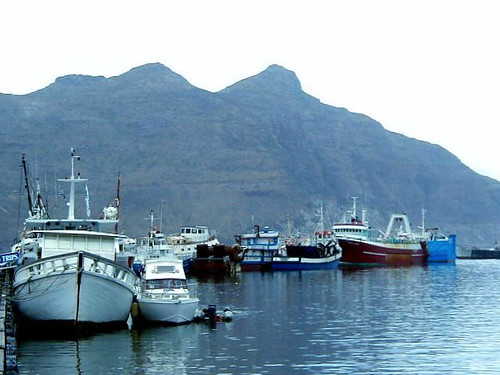
boats leaving for Seal Island at the Mariner’s wharf
Then the drive took a turn to a series of beautiful white beaches along the western arc of False Bay. We stopped at several points. One particular promontory in Camp’s Bay gave us a jaw-dropping view of the famous Twelve Apostles peak.
the Twelve Apostles peaks, as seen from Camp’s Bay
As we went further south, I could not help notice that along the hilly banks are houses of the rich and fabulous. The year 2001 was a little more than 5 years after the lifting of apartheid so despite the affluent projection of the city – there definitely was that Mediterranean feel all throughout the route – you could still sense a palpable economic divide among the white Afrikaners and the black majority.
Crime rate must be high. The villas definitely were fully guarded, with high walls and electrical fences. Signs of “Armed Response” were all over the place, which meant that a private protection agency provides immediate assistance to the household within minutes of intrusion. Vehicles are likewise under a similar 24 hour protection from hi-jacking. In fact, to facilitate helicopter assistance, cars also are painted numbers on their roofs for quick tracking. Coming from a developing country like the Philippines where crime is also an issue, I shook this off nonchalantly. 
houses along Boulder Beach are typical of the affluent residences along False Beach
The coastline of False Bay boasts of seemingly endless white beaches, with names like Muizenberg, St. James and Kalk Bay. The water temperatures were not to my liking though. It was February, the height of summer, but the surface temperatures were in the low 20s centigrade. That cold I could not stand so never was I tempted to dive in.
Africa is in your face all throughout the drive. There were stops to show us an ostrich farm, heather meadows and troops of baboon.
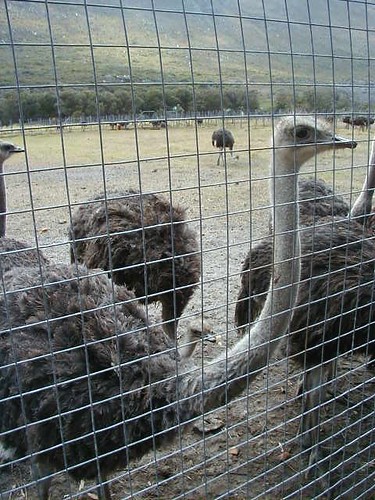
an ostrich farm at the Cape of Good Hope Nature Reserve
What impressed me most, as far as animal showcases were concerned was the detour at the Boulders Beach Coastal Park in Simon’s Town for the world renowned colony of African (Jackass) penguins (Sphensicus demersus, so named for the donkey-like cry they make when on land. 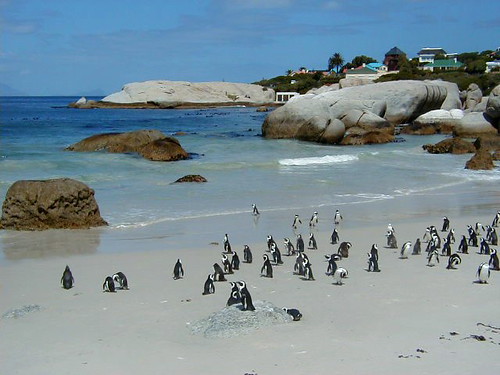
a waddling colony of penguins at Boulder’s Beach, Simon’s Town, South Africa
This was my first time to see real penguins in their habitat and what a habitat they chose! Of all 16 species of penguins spread in only 28 sites in the world, it is these penguins which uniquely inhabit a public beach where people also frequent. While these birds are almost totally adept at sea, spending long periods in the waters to feed on pichard, fish and squid, they are clumsy on land. 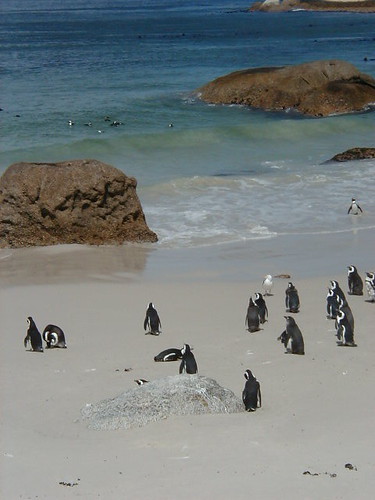
more penguins at Boulders Beach, False Bay, South Africa
True enough up to the 1970s, these penguins were vulnerable to human exploitation and predators. In the last 30 years though, they are now protected by the Southern African National Foundation for the Conservation of Coastal Birds (check out sanccob.co.za) which is considered to be among the most successful sea bird rehabilitation centers in the world. Protection of their breeding grounds in the beach is stipulated by law. In fact, signages all throughout Boulder’s Beach indicated how far-reaching the safeguards, even to the point of humor.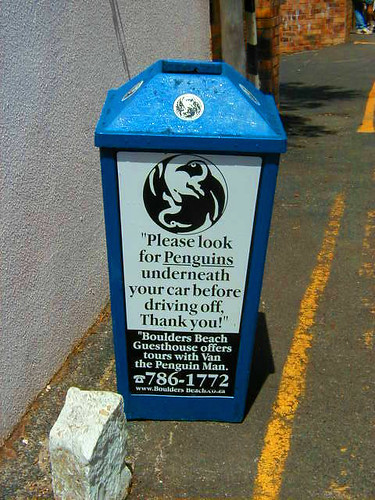
a sign at Boulders Beach which made me smile
Next, the conclusion: Cape of Good Hope and Capepoint
For Cape tours, check out classiccape.co.za. Today, the tour charge is R525/person exclusive of cablecar ticket vs R285 in 2001. Tours depart from Capetown 09:00 and return 17:00.






1 comment:
Post a Comment